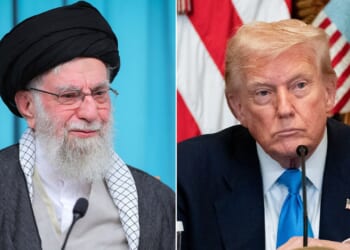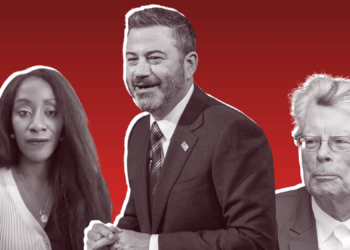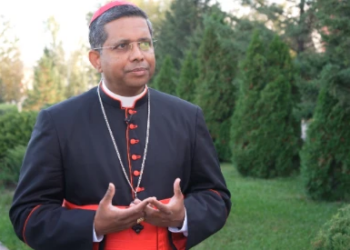If Trump destroys the Maduro regime now, the Russians will not be able to place hypersonic weapons in America’s hemisphere later.
There is speculation that Russia is in consultations with the Maduro regime to place their new Oreshnik hypersonic missile in Venezuela.
The rumors bring to mind the Cuban missile crisis.
For two weeks in October 1962, the Kennedy administration jockeyed against Nikita Khrushchev’s Soviet Union over the fate of Soviet nuclear forces that had been secreted into Communist Cuba.
The Soviets had violated the Monroe Doctrine by placing intermediate range ballistic missiles (IRBMs) just 90 miles off the coast of Florida. To the Soviets, this was a matter of just deserts—after all, the Americans had placed IRBMs along the southern periphery near the Soviet border in NATO member Turkey.
A New Cuban Missile Crisis—in Venezuela
Much like Khrushchev during the Cuban Missile Crisis, Russian leader Vladimir Putin believes placing hypersonic missiles in Venezuela will both send a message of resolve to Washington—and warn Trump away from future escalations like Friday’s submarine stunt. The Putin government likely believes that this move would restore deterrence.
But it will not. The Oreshnik is more advanced than any weapon that the United States has in its arsenal. What’s more, there is no active defense against the Oreshnik hypersonic weapon in America’s arsenal. By placing this system within America’s hemisphere, the Russians would be ensuring that the United States could not even react in time before the weapon was launched at America.
In other words, the Russians are not restoring deterrence with the United States. Deterrence is built upon some degree of mutual assured destruction (MAD). By placing a weapon like the Oreshnik in Venezuela, Moscow would be further destabilizing the balance of terror between the United States and Russia—further eroding deterrence and ensuring that war between Russia and the United States is more likely, not less.
Even if the Russians don’t follow through and place the Oreshnik in Venezuela right now, given the poor state of relations between Washington and Moscow, it is likely that the Russians will make good on this threat at some point in the future. It is therefore incumbent upon US leadership to remove the threat now. Washington should not attack Russia, or threaten the Kremlin with further nuclear escalation. It should instead work to remove the Maduro regime from power entirely.
The Cuban Missile Crisis Could Have Been Avoided
To understand the US reaction to the Soviet Union’s attempt to place missiles in Cuba in 1962, one must first understand its leaders’ understanding of the threats to American security in that era. Only two decades earlier, the Imperial Japanese Navy had caught the United States unawares at Pearl Harbor, devastating the US Navy and leading to the deaths of more than 2,400 sailors and soldiers.
With that precedent, American military leaders were enraged at the possibility of the Soviet Union having the capacity for a similar attack—this time with nuclear weapons. That explains the combined paranoia of the US military and intelligence services, and why they were eager to pursue any action necessary to push the Soviets out of Cuba—even including military strikes, a step that President Kennedy and many in civilian leadership were understandably more skeptical of.
The entire ordeal, however, could have been avoided had Fidel Castro been prevented from rising to power. When Castro stormed the beaches of Cuba waving the banner of Communist revolution against the corrupt pro-American dictatorship of Fulgencio Batista, the path to the Cuban Missile Crisis was set. Local security services and US intelligence agencies likely could have stopped Castro’s march on Havana. Failing that, the Americans might have planned a better end to the Castro regime by following through with the Bay of Pigs. But by 1962, both opportunities had been lost.
Cuba Yesterday Is Venezuela Today
Since 2002, the United States has been plagued by a regime that is dangerously similar to Castro’s regime in Havana—the thuggish socialist regime in Venezuela.
Initially created by the disaffected Venezuelan Army colonel Hugo Chavez, and today run by his former right-hand man Nicolas Maduro, Venezuela has shaped itself into one of the key points of resistance against the United States in the Western Hemisphere. Indeed, the Chavismo regime in Caracas has replaced the threat that the Castroite regime in Cuba once posed to the United States. (Of course, Cuba’s government remains hostile to America, but is no longer in any position to threaten it militarily.)
The Chavismo regime under Nicolas Maduro stands accused of many crimes against the American people. Among those crimes has been Maduro’s unapologetic support of the cartels that are trafficking narcotics, people, and illicit arms into the United States. Relatedly, multiple Venezuelan dissidents who have found refuge in the United States have insisted that the introduction of the Tren de Aragua prison gang into the United States’ already violent gangland milieu was not merely the result of weak border enforcement under the Biden administration. According to these dissidents, Tren de Aragua is a paramilitary force that operates as a branch of the Maduro regime. When Tren de Aragua is deployed overseas, it not only establishes drug and human trafficking operations—earning precious hard currency for Caracas—but also targets the Venezuelan political dissidents who have found refuge among the diaspora in the United States.
How Russia Is Tied to the US-Venezuela Crisis
If Russia were in a position to place its missiles in Cuba once again, it might exercise that option. But the Cuban Missile Crisis set the precedent that the United States would never allow Russian arms so close to its shore. If Putin tried to replicate Khrushchev’s move in 1962, it would place the two countries at the brink of nuclear war. Perhaps most importantly, the Cubans themselves understand this, and would probably not allow Russia to make such a move.
But the Kremlin may find a friendlier reception in Venezuela. Caracas and Moscow already enjoy cordial political and economic ties. Nicolas Maduro is intensely anti-American. The Venezuelan regime feels under siege—not least because of Maduro’s loss in the transparently rigged presidential election in 2024, and the enormous street protests that followed. Maduro has framed these protests as an illegitimate attempt by the United States to remove him from power. What better protection might he have from a more overt American attempt than a handful of Russia’s most dangerous missiles, much as Castro had in 1962?
Trump Must Remove the Maduro Regime Now
Remember, removing Castro from power in Cuba before 1962 would have avoided the Cuban Missile Crisis entirely. If Trump destroys the Maduro regime now, the Russians will not be able to place hypersonic weapons in America’s hemisphere later.
Moreover, securing Venezuela as a more compliant nation in the Western Hemisphere would ensure that the US could dominate the nearby Panama Canal Zone more thoroughly—a step that Trump has called for since taking office in January.
But allowing for the Maduro regime to persist, with talk about that government placing Russian Oreshniks on their territory, is a direct threat to the United States. Only by ending the Maduro regime can America ensure its safety from Russian hypersonic weapons in its hemisphere.
About the Author: Brandon J. Weichert
Brandon J. Weichert, a Senior National Security Editor at The National Interest as well as a contributor at Popular Mechanics, who consults regularly with various government institutions and private organizations on geopolitical issues. Weichert’s writings have appeared in multiple publications, including the Washington Times, National Review, The American Spectator, MSN, the Asia Times, and countless others. His books include Winning Space: How America Remains a Superpower, Biohacked: China’s Race to Control Life, and The Shadow War: Iran’s Quest for Supremacy. His newest book, A Disaster of Our Own Making: How the West Lost Ukraine is available for purchase wherever books are sold. He can be followed via Twitter @WeTheBrandon.
Image: Shutterstock / StringerAL.


















